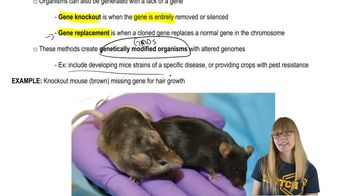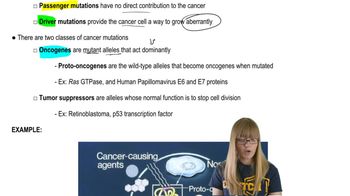Table of contents
- 1. Introduction to Genetics51m
- 2. Mendel's Laws of Inheritance3h 37m
- 3. Extensions to Mendelian Inheritance2h 41m
- 4. Genetic Mapping and Linkage2h 28m
- 5. Genetics of Bacteria and Viruses1h 21m
- 6. Chromosomal Variation1h 48m
- 7. DNA and Chromosome Structure56m
- 8. DNA Replication1h 10m
- 9. Mitosis and Meiosis1h 34m
- 10. Transcription1h 0m
- 11. Translation58m
- 12. Gene Regulation in Prokaryotes1h 19m
- 13. Gene Regulation in Eukaryotes44m
- 14. Genetic Control of Development44m
- 15. Genomes and Genomics1h 50m
- 16. Transposable Elements47m
- 17. Mutation, Repair, and Recombination1h 6m
- 18. Molecular Genetic Tools19m
- 19. Cancer Genetics29m
- 20. Quantitative Genetics1h 26m
- 21. Population Genetics50m
- 22. Evolutionary Genetics29m
19. Cancer Genetics
Cancer Mutations
Problem 6a
Textbook Question
Radiation is frequently used as part of the treatment of cancer. The radiation works by damaging DNA and components of the cell. Under what circumstances do you think radiation treatment is a good choice to treat cancer?
 Verified step by step guidance
Verified step by step guidance1
<Understand the mechanism of radiation therapy: Radiation therapy works by damaging the DNA of cancer cells, which inhibits their ability to reproduce and grow.>
<Consider the type and stage of cancer: Radiation therapy is often used for localized cancers where the goal is to target and destroy cancer cells in a specific area.>
<Evaluate the patient's overall health and treatment goals: Radiation may be a good choice if the patient is healthy enough to tolerate the treatment and if the goal is to shrink tumors or eliminate cancer cells.>
<Assess the potential side effects and risks: Consider the potential side effects of radiation therapy, such as damage to surrounding healthy tissue, and weigh these against the benefits.>
<Consult with a multidisciplinary team: A team of healthcare professionals, including oncologists and radiologists, should be involved in deciding if radiation therapy is the best option for the patient.>
Recommended similar problem, with video answer:
 Verified Solution
Verified SolutionThis video solution was recommended by our tutors as helpful for the problem above
Video duration:
1mPlay a video:
Was this helpful?
Key Concepts
Here are the essential concepts you must grasp in order to answer the question correctly.
Mechanism of Radiation Therapy
Radiation therapy works by using high-energy particles or waves, such as X-rays or gamma rays, to damage the DNA of cancer cells. This damage inhibits the cells' ability to divide and grow, ultimately leading to cell death. Understanding how radiation interacts with cellular components is crucial for determining its effectiveness in targeting rapidly dividing cancer cells.
Recommended video:
Guided course

Transgenic Organisms and Gene Therapy
Types of Cancer
Different types of cancer respond variably to radiation therapy based on their growth rates, location, and genetic characteristics. For instance, localized tumors, such as those in the breast or prostate, may be more effectively treated with radiation compared to metastatic cancers, which have spread to multiple sites. Identifying the specific cancer type is essential for evaluating the appropriateness of radiation treatment.
Recommended video:
Guided course

Cancer Mutations
Patient Factors and Treatment Planning
The decision to use radiation therapy also depends on individual patient factors, including overall health, age, and previous treatments. Factors such as the stage of cancer, the patient's ability to tolerate treatment, and potential side effects must be considered. A comprehensive treatment plan tailored to the patient's unique circumstances is vital for optimizing outcomes in cancer therapy.
Recommended video:
Guided course

F Factor and Hfr

 4:50m
4:50mWatch next
Master Cancer Mutations with a bite sized video explanation from Kylia Goodner
Start learningRelated Videos
Related Practice

